MBA 603 Operations Management: Activity on Productivity and Demand
VerifiedAdded on 2023/01/12
|7
|1124
|63
Homework Assignment
AI Summary
This assignment solution for MBA 603 Operations Management addresses two class activities. The first activity focuses on calculating labor hour productivity, multi-factor productivity, and identifying a productivity index at a workplace, with an example of a labor-weighted production index. The second activity involves forecasting demand for April and May using the weighted moving average method, providing detailed calculations. The report concludes that productivity is an important measurement tool for management to compare the efficiency of production processes. The moving average method is used for forecasting demand and sales. The solution provides a comprehensive overview of productivity analysis and forecasting techniques.
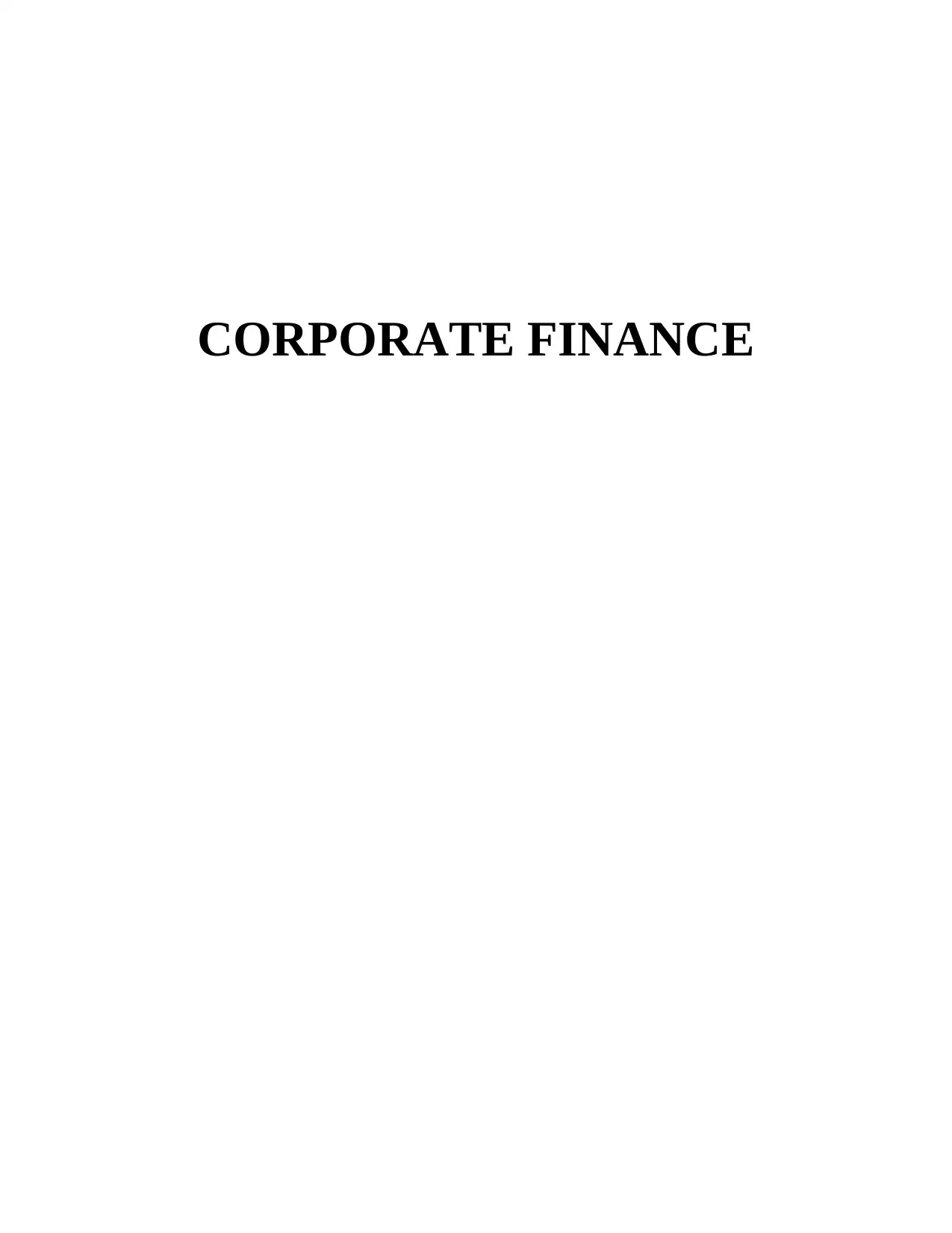
CORPORATE FINANCE
Paraphrase This Document
Need a fresh take? Get an instant paraphrase of this document with our AI Paraphraser
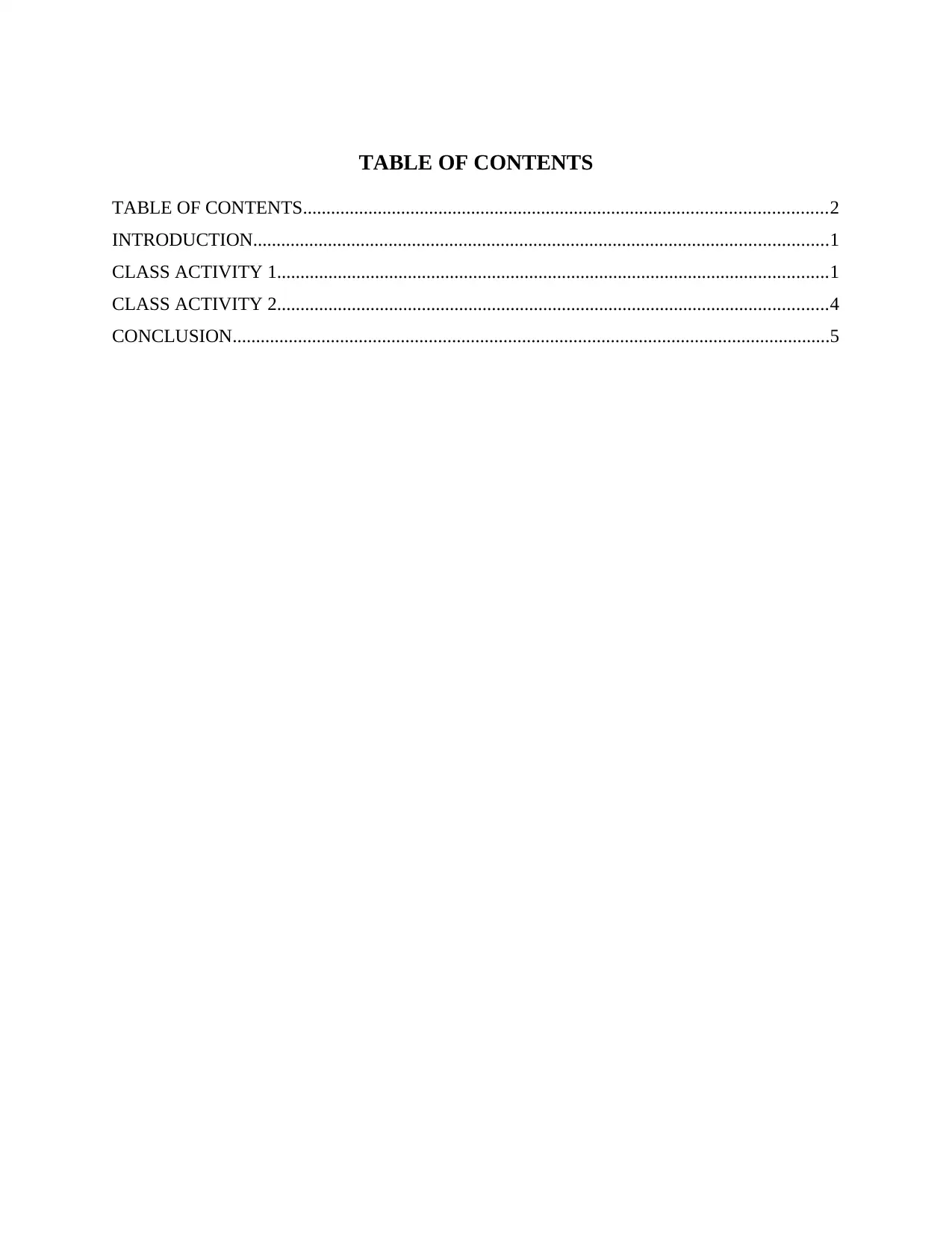
TABLE OF CONTENTS
TABLE OF CONTENTS................................................................................................................2
INTRODUCTION...........................................................................................................................1
CLASS ACTIVITY 1......................................................................................................................1
CLASS ACTIVITY 2......................................................................................................................4
CONCLUSION................................................................................................................................5
TABLE OF CONTENTS................................................................................................................2
INTRODUCTION...........................................................................................................................1
CLASS ACTIVITY 1......................................................................................................................1
CLASS ACTIVITY 2......................................................................................................................4
CONCLUSION................................................................................................................................5
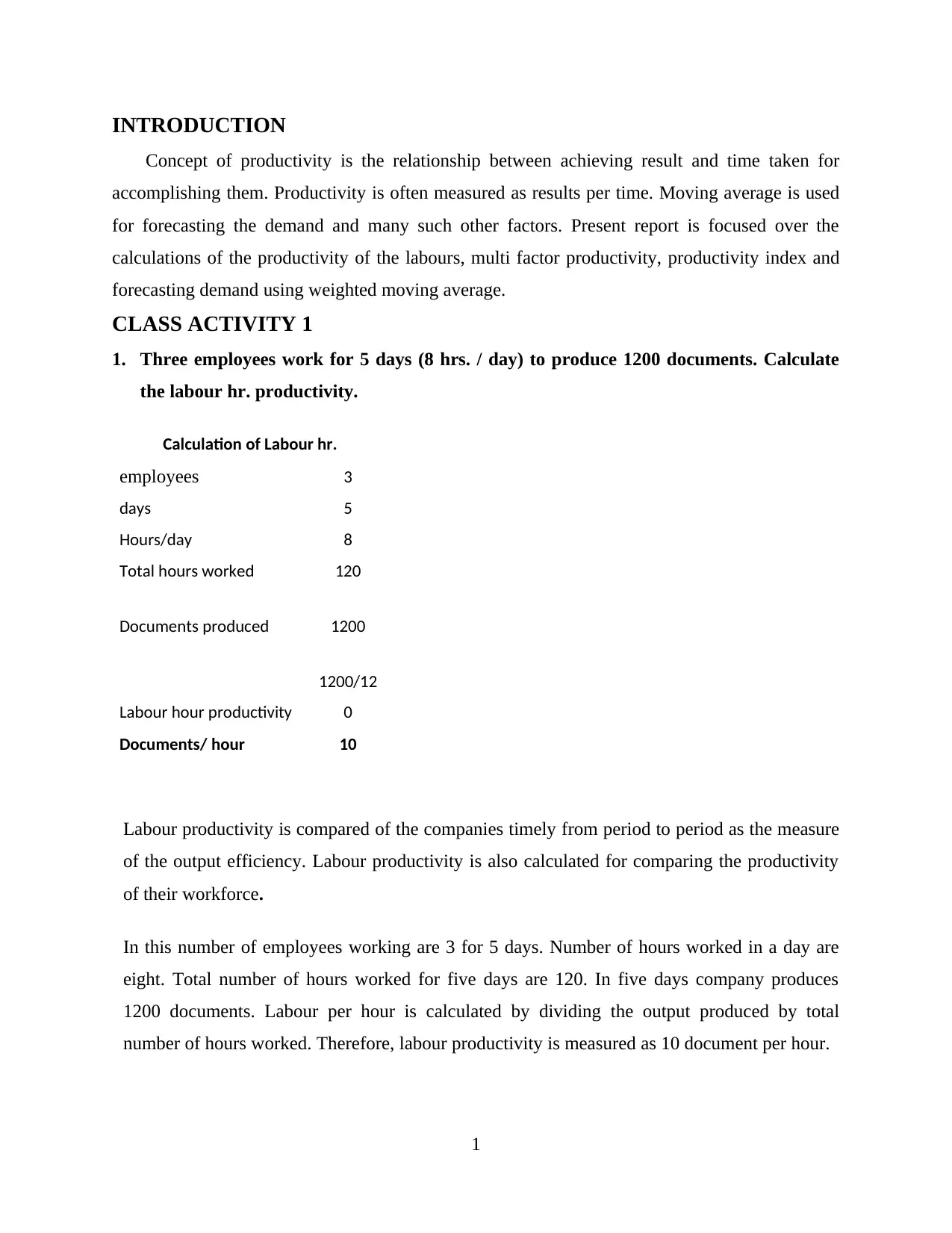
INTRODUCTION
Concept of productivity is the relationship between achieving result and time taken for
accomplishing them. Productivity is often measured as results per time. Moving average is used
for forecasting the demand and many such other factors. Present report is focused over the
calculations of the productivity of the labours, multi factor productivity, productivity index and
forecasting demand using weighted moving average.
CLASS ACTIVITY 1
1. Three employees work for 5 days (8 hrs. / day) to produce 1200 documents. Calculate
the labour hr. productivity.
Calculation of Labour hr.
employees 3
days 5
Hours/day 8
Total hours worked 120
Documents produced 1200
Labour hour productivity
1200/12
0
Documents/ hour 10
Labour productivity is compared of the companies timely from period to period as the measure
of the output efficiency. Labour productivity is also calculated for comparing the productivity
of their workforce.
In this number of employees working are 3 for 5 days. Number of hours worked in a day are
eight. Total number of hours worked for five days are 120. In five days company produces
1200 documents. Labour per hour is calculated by dividing the output produced by total
number of hours worked. Therefore, labour productivity is measured as 10 document per hour.
1
Concept of productivity is the relationship between achieving result and time taken for
accomplishing them. Productivity is often measured as results per time. Moving average is used
for forecasting the demand and many such other factors. Present report is focused over the
calculations of the productivity of the labours, multi factor productivity, productivity index and
forecasting demand using weighted moving average.
CLASS ACTIVITY 1
1. Three employees work for 5 days (8 hrs. / day) to produce 1200 documents. Calculate
the labour hr. productivity.
Calculation of Labour hr.
employees 3
days 5
Hours/day 8
Total hours worked 120
Documents produced 1200
Labour hour productivity
1200/12
0
Documents/ hour 10
Labour productivity is compared of the companies timely from period to period as the measure
of the output efficiency. Labour productivity is also calculated for comparing the productivity
of their workforce.
In this number of employees working are 3 for 5 days. Number of hours worked in a day are
eight. Total number of hours worked for five days are 120. In five days company produces
1200 documents. Labour per hour is calculated by dividing the output produced by total
number of hours worked. Therefore, labour productivity is measured as 10 document per hour.
1
⊘ This is a preview!⊘
Do you want full access?
Subscribe today to unlock all pages.

Trusted by 1+ million students worldwide
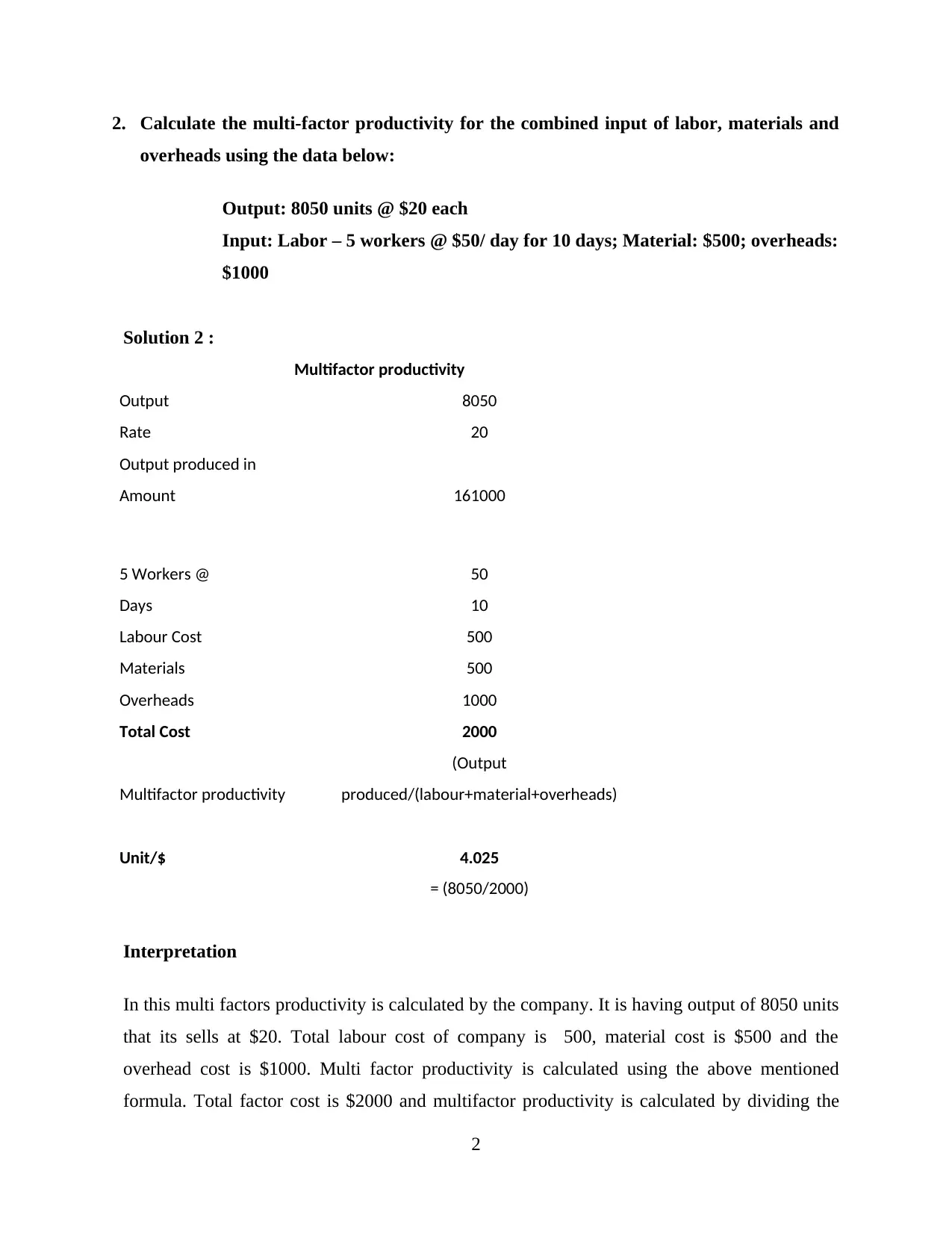
2. Calculate the multi-factor productivity for the combined input of labor, materials and
overheads using the data below:
Output: 8050 units @ $20 each
Input: Labor – 5 workers @ $50/ day for 10 days; Material: $500; overheads:
$1000
Solution 2 :
Multifactor productivity
Output 8050
Rate 20
Output produced in
Amount 161000
5 Workers @ 50
Days 10
Labour Cost 500
Materials 500
Overheads 1000
Total Cost 2000
Multifactor productivity
(Output
produced/(labour+material+overheads)
Unit/$ 4.025
= (8050/2000)
Interpretation
In this multi factors productivity is calculated by the company. It is having output of 8050 units
that its sells at $20. Total labour cost of company is 500, material cost is $500 and the
overhead cost is $1000. Multi factor productivity is calculated using the above mentioned
formula. Total factor cost is $2000 and multifactor productivity is calculated by dividing the
2
overheads using the data below:
Output: 8050 units @ $20 each
Input: Labor – 5 workers @ $50/ day for 10 days; Material: $500; overheads:
$1000
Solution 2 :
Multifactor productivity
Output 8050
Rate 20
Output produced in
Amount 161000
5 Workers @ 50
Days 10
Labour Cost 500
Materials 500
Overheads 1000
Total Cost 2000
Multifactor productivity
(Output
produced/(labour+material+overheads)
Unit/$ 4.025
= (8050/2000)
Interpretation
In this multi factors productivity is calculated by the company. It is having output of 8050 units
that its sells at $20. Total labour cost of company is 500, material cost is $500 and the
overhead cost is $1000. Multi factor productivity is calculated using the above mentioned
formula. Total factor cost is $2000 and multifactor productivity is calculated by dividing the
2
Paraphrase This Document
Need a fresh take? Get an instant paraphrase of this document with our AI Paraphraser
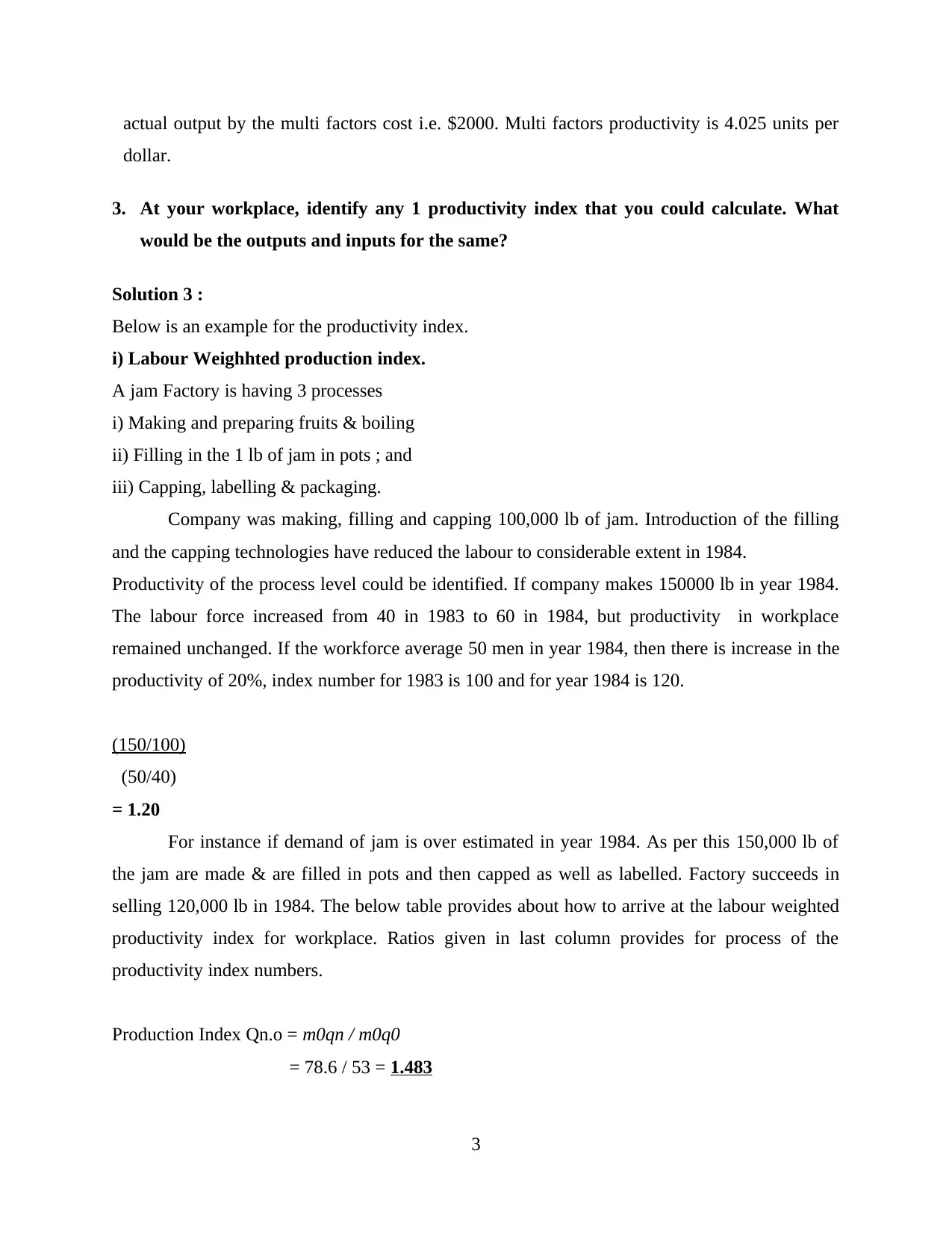
actual output by the multi factors cost i.e. $2000. Multi factors productivity is 4.025 units per
dollar.
3. At your workplace, identify any 1 productivity index that you could calculate. What
would be the outputs and inputs for the same?
Solution 3 :
Below is an example for the productivity index.
i) Labour Weighhted production index.
A jam Factory is having 3 processes
i) Making and preparing fruits & boiling
ii) Filling in the 1 lb of jam in pots ; and
iii) Capping, labelling & packaging.
Company was making, filling and capping 100,000 lb of jam. Introduction of the filling
and the capping technologies have reduced the labour to considerable extent in 1984.
Productivity of the process level could be identified. If company makes 150000 lb in year 1984.
The labour force increased from 40 in 1983 to 60 in 1984, but productivity in workplace
remained unchanged. If the workforce average 50 men in year 1984, then there is increase in the
productivity of 20%, index number for 1983 is 100 and for year 1984 is 120.
(150/100)
(50/40)
= 1.20
For instance if demand of jam is over estimated in year 1984. As per this 150,000 lb of
the jam are made & are filled in pots and then capped as well as labelled. Factory succeeds in
selling 120,000 lb in 1984. The below table provides about how to arrive at the labour weighted
productivity index for workplace. Ratios given in last column provides for process of the
productivity index numbers.
Production Index Qn.o = m0qn / m0q0
= 78.6 / 53 = 1.483
3
dollar.
3. At your workplace, identify any 1 productivity index that you could calculate. What
would be the outputs and inputs for the same?
Solution 3 :
Below is an example for the productivity index.
i) Labour Weighhted production index.
A jam Factory is having 3 processes
i) Making and preparing fruits & boiling
ii) Filling in the 1 lb of jam in pots ; and
iii) Capping, labelling & packaging.
Company was making, filling and capping 100,000 lb of jam. Introduction of the filling
and the capping technologies have reduced the labour to considerable extent in 1984.
Productivity of the process level could be identified. If company makes 150000 lb in year 1984.
The labour force increased from 40 in 1983 to 60 in 1984, but productivity in workplace
remained unchanged. If the workforce average 50 men in year 1984, then there is increase in the
productivity of 20%, index number for 1983 is 100 and for year 1984 is 120.
(150/100)
(50/40)
= 1.20
For instance if demand of jam is over estimated in year 1984. As per this 150,000 lb of
the jam are made & are filled in pots and then capped as well as labelled. Factory succeeds in
selling 120,000 lb in 1984. The below table provides about how to arrive at the labour weighted
productivity index for workplace. Ratios given in last column provides for process of the
productivity index numbers.
Production Index Qn.o = m0qn / m0q0
= 78.6 / 53 = 1.483
3
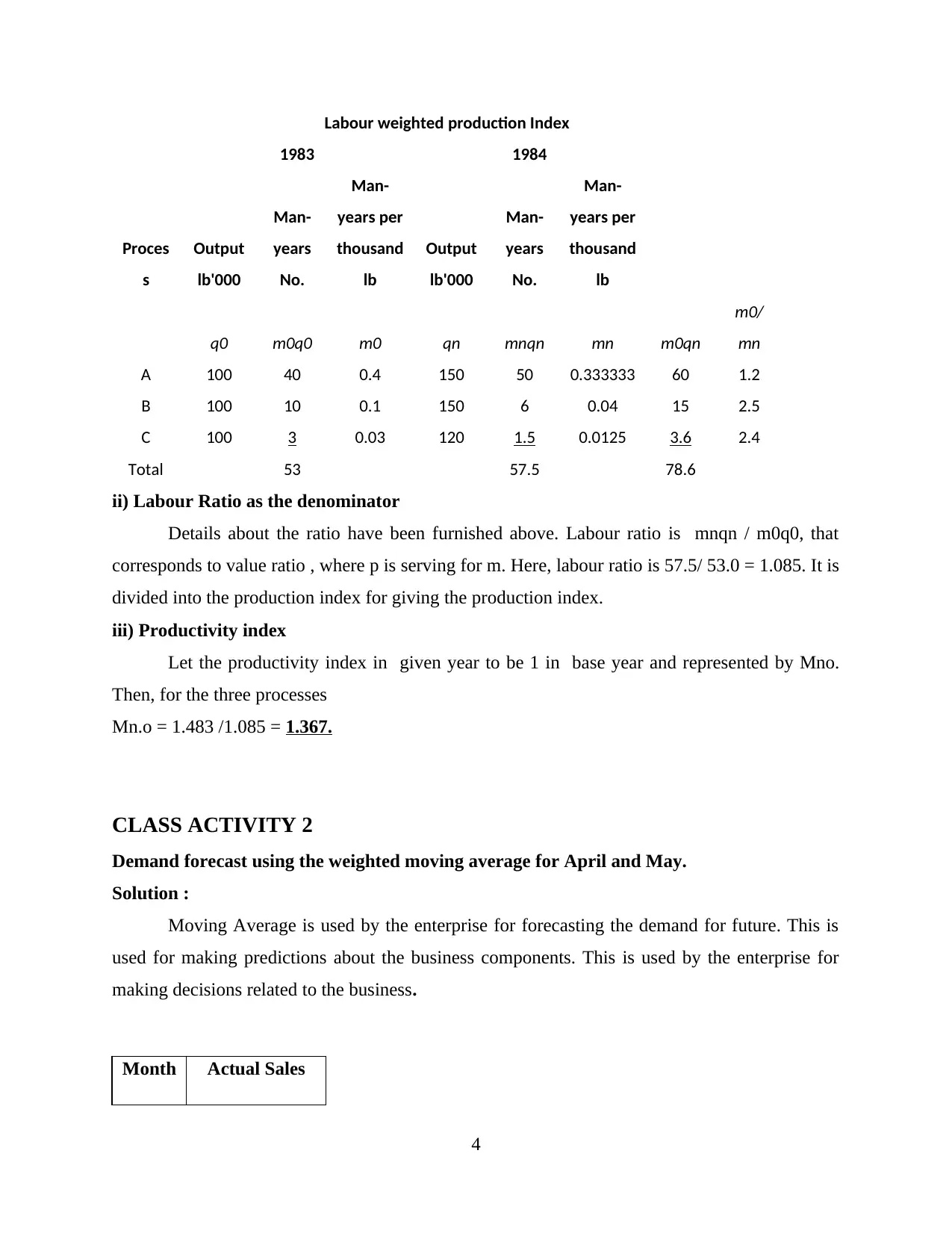
Labour weighted production Index
1983 1984
Proces
s
Output
lb'000
Man-
years
No.
Man-
years per
thousand
lb
Output
lb'000
Man-
years
No.
Man-
years per
thousand
lb
q0 m0q0 m0 qn mnqn mn m0qn
m0/
mn
A 100 40 0.4 150 50 0.333333 60 1.2
B 100 10 0.1 150 6 0.04 15 2.5
C 100 3 0.03 120 1.5 0.0125 3.6 2.4
Total 53 57.5 78.6
ii) Labour Ratio as the denominator
Details about the ratio have been furnished above. Labour ratio is mnqn / m0q0, that
corresponds to value ratio , where p is serving for m. Here, labour ratio is 57.5/ 53.0 = 1.085. It is
divided into the production index for giving the production index.
iii) Productivity index
Let the productivity index in given year to be 1 in base year and represented by Mno.
Then, for the three processes
Mn.o = 1.483 /1.085 = 1.367.
CLASS ACTIVITY 2
Demand forecast using the weighted moving average for April and May.
Solution :
Moving Average is used by the enterprise for forecasting the demand for future. This is
used for making predictions about the business components. This is used by the enterprise for
making decisions related to the business.
Month Actual Sales
4
1983 1984
Proces
s
Output
lb'000
Man-
years
No.
Man-
years per
thousand
lb
Output
lb'000
Man-
years
No.
Man-
years per
thousand
lb
q0 m0q0 m0 qn mnqn mn m0qn
m0/
mn
A 100 40 0.4 150 50 0.333333 60 1.2
B 100 10 0.1 150 6 0.04 15 2.5
C 100 3 0.03 120 1.5 0.0125 3.6 2.4
Total 53 57.5 78.6
ii) Labour Ratio as the denominator
Details about the ratio have been furnished above. Labour ratio is mnqn / m0q0, that
corresponds to value ratio , where p is serving for m. Here, labour ratio is 57.5/ 53.0 = 1.085. It is
divided into the production index for giving the production index.
iii) Productivity index
Let the productivity index in given year to be 1 in base year and represented by Mno.
Then, for the three processes
Mn.o = 1.483 /1.085 = 1.367.
CLASS ACTIVITY 2
Demand forecast using the weighted moving average for April and May.
Solution :
Moving Average is used by the enterprise for forecasting the demand for future. This is
used for making predictions about the business components. This is used by the enterprise for
making decisions related to the business.
Month Actual Sales
4
⊘ This is a preview!⊘
Do you want full access?
Subscribe today to unlock all pages.

Trusted by 1+ million students worldwide
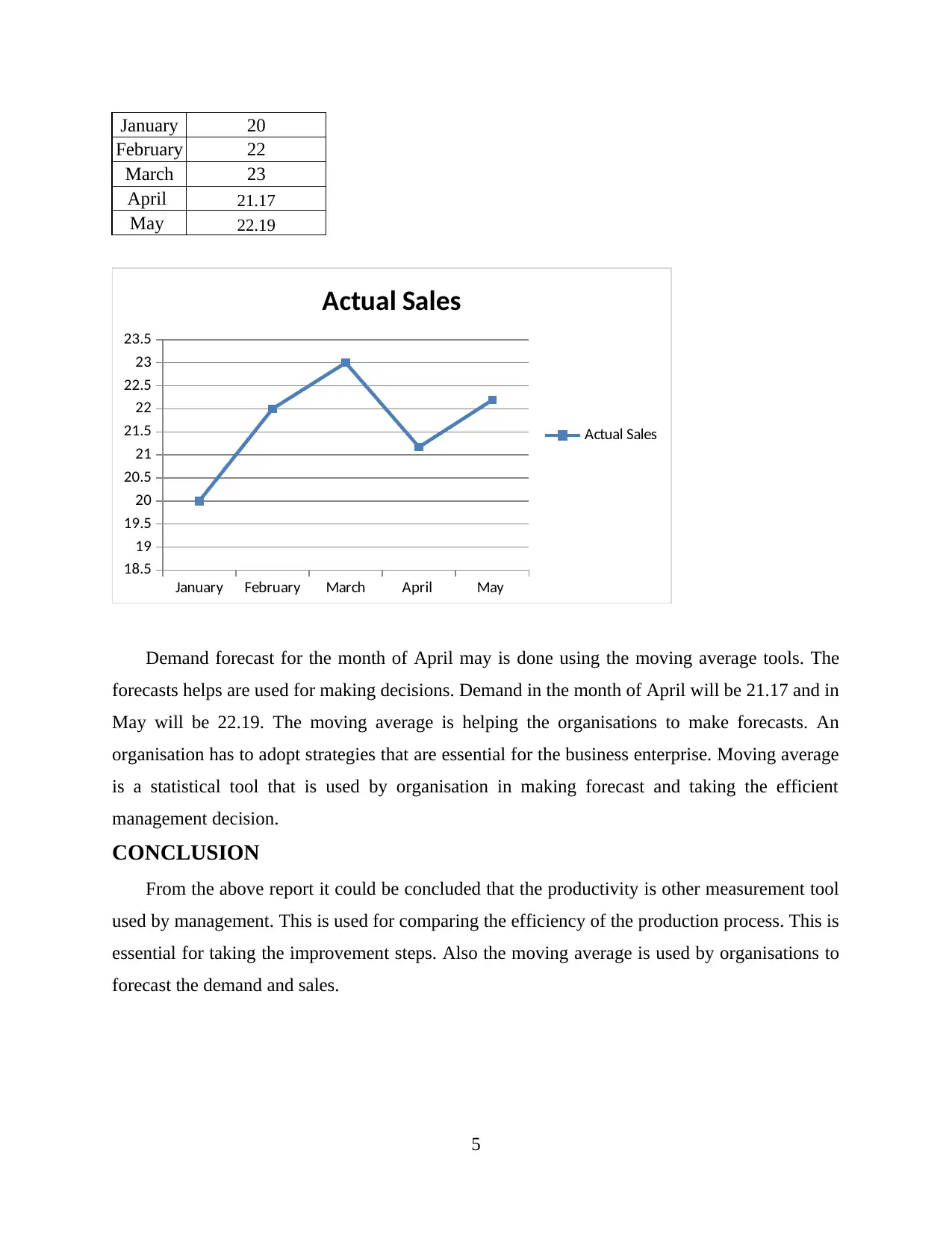
January 20
February 22
March 23
April 21.17
May 22.19
January February March April May
18.5
19
19.5
20
20.5
21
21.5
22
22.5
23
23.5
Actual Sales
Actual Sales
Demand forecast for the month of April may is done using the moving average tools. The
forecasts helps are used for making decisions. Demand in the month of April will be 21.17 and in
May will be 22.19. The moving average is helping the organisations to make forecasts. An
organisation has to adopt strategies that are essential for the business enterprise. Moving average
is a statistical tool that is used by organisation in making forecast and taking the efficient
management decision.
CONCLUSION
From the above report it could be concluded that the productivity is other measurement tool
used by management. This is used for comparing the efficiency of the production process. This is
essential for taking the improvement steps. Also the moving average is used by organisations to
forecast the demand and sales.
5
February 22
March 23
April 21.17
May 22.19
January February March April May
18.5
19
19.5
20
20.5
21
21.5
22
22.5
23
23.5
Actual Sales
Actual Sales
Demand forecast for the month of April may is done using the moving average tools. The
forecasts helps are used for making decisions. Demand in the month of April will be 21.17 and in
May will be 22.19. The moving average is helping the organisations to make forecasts. An
organisation has to adopt strategies that are essential for the business enterprise. Moving average
is a statistical tool that is used by organisation in making forecast and taking the efficient
management decision.
CONCLUSION
From the above report it could be concluded that the productivity is other measurement tool
used by management. This is used for comparing the efficiency of the production process. This is
essential for taking the improvement steps. Also the moving average is used by organisations to
forecast the demand and sales.
5
1 out of 7
Your All-in-One AI-Powered Toolkit for Academic Success.
+13062052269
info@desklib.com
Available 24*7 on WhatsApp / Email
![[object Object]](/_next/static/media/star-bottom.7253800d.svg)
Unlock your academic potential
Copyright © 2020–2025 A2Z Services. All Rights Reserved. Developed and managed by ZUCOL.

